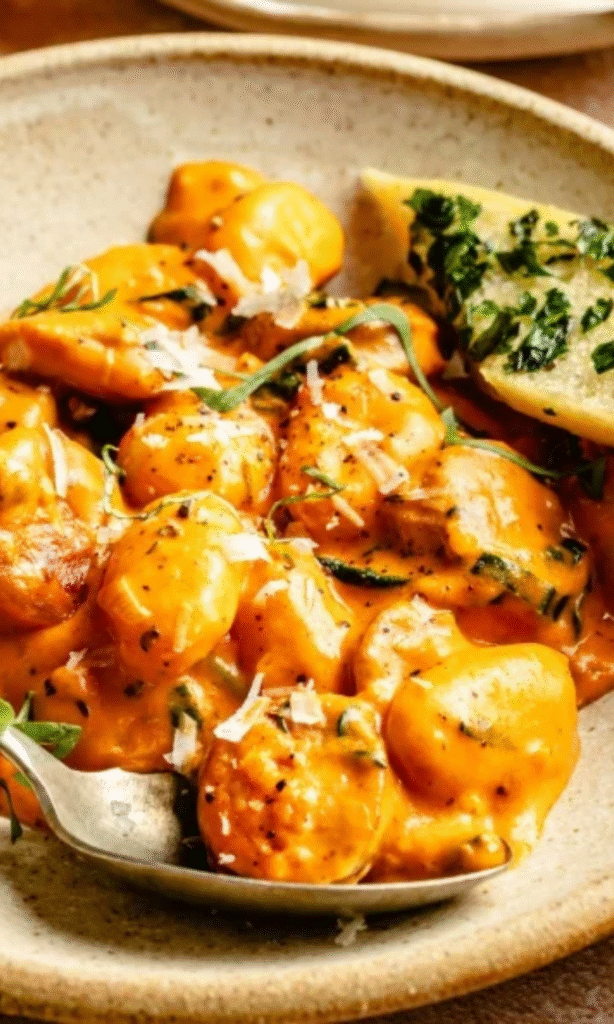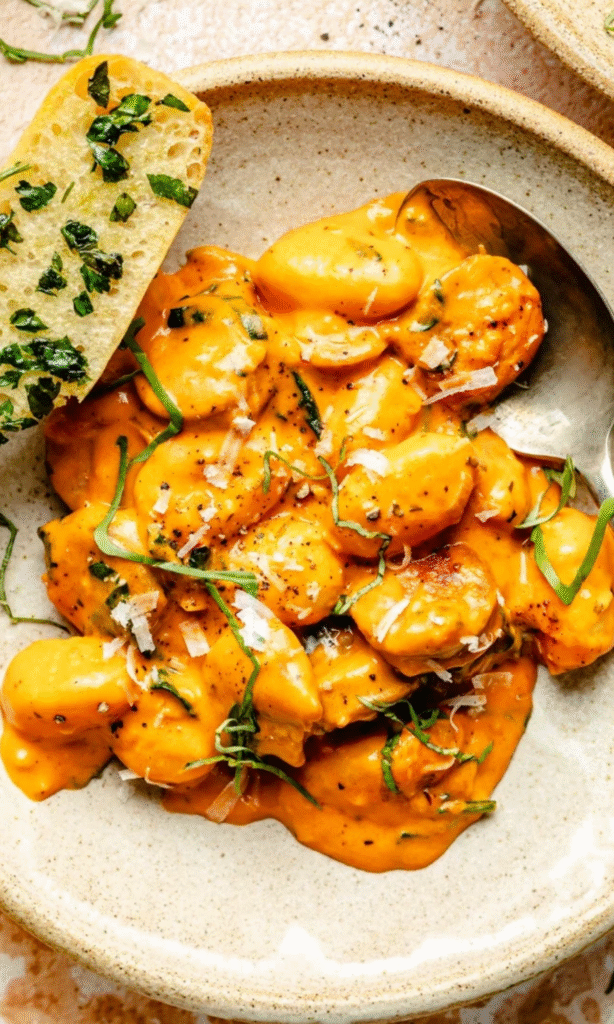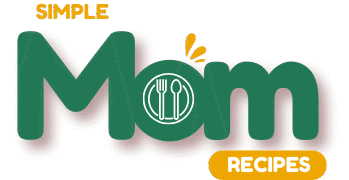Sometimes you need comfort food that doesn’t leave you sluggish afterward. That’s exactly what this high protein tomato gnocchi delivers — all the cozy, satisfying warmth of traditional gnocchi in tomato sauce, but with a secret ingredient that transforms it into something genuinely nourishing.
The magic happens with cottage cheese, which you literally cannot taste once it’s blended into the sauce. What it does instead is create this incredibly creamy, luxurious texture while quietly boosting the protein content to impressive levels. It’s one of those brilliant kitchen tricks that makes you feel a bit like a culinary genius.
Why This Recipe Works So Well
Let’s be honest — most gnocchi dishes are essentially pasta swimming in sauce. Delicious? Absolutely. Filling for more than an hour? Not so much. This version changes that equation completely.
The cottage cheese doesn’t just add protein; it transforms the entire sauce structure. When blended smooth, it creates this velvety base that coats each piece of gnocchi perfectly. You get that restaurant-quality richness without heavy cream or excessive amounts of cheese. Plus, with roughly 25 grams of protein per serving, this dish actually keeps you satisfied.
What really makes this recipe special is how approachable it is. No fancy techniques, no hard-to-find ingredients, and definitely no lengthy prep work. It’s the kind of meal that works equally well for a quick weeknight dinner or when you want to impress someone without breaking a sweat.
Ingredients Needed for the Recipe
The beauty of this dish lies in its simplicity. Here’s what you’ll need to create this protein-packed comfort food:
For the base:
– 1 onion, finely chopped
– 4 garlic cloves, finely chopped
– 1/4 teaspoon chili flakes
– 1/4 teaspoon dried oregano
– 20g tomato paste
– 200g chopped tomatoes
– 200g cottage cheese
– 300g gnocchi
– Oil and salt for cooking
For the finishing touches:
– Grated Parmesan cheese
– Extra chili flakes
– Fresh chopped parsley
That’s it! Notice how there’s nothing exotic or expensive on this list. Most of these ingredients probably live in your pantry already, which makes this recipe perfect for those “what can I make with what I have” moments.
The Best Cottage Cheese to Use
Not all cottage cheese is created equal for this recipe. You want something with a reasonably smooth texture — those giant, chunky curds won’t blend as seamlessly. Full-fat cottage cheese works best because it creates the richest sauce, but 2% works perfectly fine if that’s what you prefer.
Here’s a little trick: if your cottage cheese seems particularly lumpy, give it a quick stir before measuring. Sometimes the curds settle and a gentle mix redistributes everything more evenly. Some brands are naturally smoother than others, so don’t worry if yours looks different from what you’re used to.
The key thing to remember is that once this gets blended, even the chunkiest cottage cheese transforms into silk. The blender is your friend here — it completely eliminates any texture concerns and creates that gorgeous, creamy base that makes this sauce so special.
How to make High Protein Tomato Gnocchi?

Step 1: Build Your Flavor Base
Heat 1-2 tablespoons of oil in a medium saucepan over medium heat. Add your finely chopped onion along with a good pinch of salt. This isn’t just seasoning — the salt helps draw moisture from the onion, which speeds up the softening process and develops better flavor.
Cook the onion until it’s soft and sweet, which usually takes about 5-7 minutes. You’ll know it’s ready when it becomes translucent and starts to smell amazing. Don’t rush this step; properly cooked onions are the foundation of great flavor in this dish.
Step 2: Add the Aromatics
Stir in your minced garlic, chili flakes, dried oregano, and tomato paste. This is where the kitchen starts to smell incredible. Fry everything together for about 2 minutes, stirring regularly to prevent anything from burning.
The tomato paste needs this cooking time to develop its flavor — raw tomato paste tastes sharp and metallic, but cooked tomato paste becomes rich and complex. You’ll actually see the color deepen as it cooks, which is your visual cue that good things are happening.
Step 3: Add the Tomatoes and Simmer
Pour in your chopped tomatoes and let everything simmer for 5 minutes. This gives the flavors time to meld together and allows some of the liquid to reduce, which concentrates the taste.
While this is happening, get your gnocchi cooking according to the package directions. Fresh gnocchi usually takes just 2-3 minutes (they float when done), while shelf-stable versions might need 4-5 minutes. Time this so both components finish around the same time.
Step 4: Create the Magic Sauce
Here’s where the transformation happens. Pour your tomato sauce into a blender along with the cottage cheese. Blend until completely smooth — this usually takes about 30-45 seconds, depending on your blender’s power.
The result is absolutely gorgeous: a vibrant, creamy sauce that looks like it came from an expensive restaurant. No one would ever guess there’s cottage cheese in there unless you told them.
Step 5: Combine and Serve
Return the sauce to your pan along with the cooked gnocchi. Heat everything gently — this is crucial because cottage cheese can split if it gets too hot too fast. Think gentle warming rather than aggressive reheating.
Once everything is heated through, transfer to serving bowls and top with grated Parmesan, a sprinkle of chili flakes, and fresh chopped parsley. The contrast of colors is beautiful, and each garnish adds its own layer of flavor.
Perfect Timing for This Dish
This recipe shines brightest on busy weeknights when you need something satisfying but don’t want to spend forever in the kitchen. The total time from start to finish is about 30 minutes, but most of that is hands-off simmering.
It’s also fantastic for meal prep situations. You can make the sauce ahead of time and store it in the refrigerator for up to three days. When you’re ready to eat, just cook fresh gnocchi and combine with the reheated sauce. The protein content makes it filling enough that you won’t find yourself rummaging through the pantry an hour later.
Weekend lunch is another perfect opportunity for this dish. There’s something deeply satisfying about a warm, creamy bowl of gnocchi when you have time to actually sit and enjoy it. Pair it with a simple salad and you’ve got a complete, balanced meal.
Smart Ingredient Substitutions
The beauty of this recipe is its flexibility. Don’t have gnocchi? Kelsey mentions that butter beans work wonderfully as a substitute — they’re creamy, protein-rich, and hold the sauce beautifully. Shell pasta, rigatoni, or even orzo would work well too.
If cottage cheese isn’t your thing (though remember, you truly can’t taste it), ricotta cheese makes a decent substitute. Use the same amount and blend it the same way. Greek yogurt also works, though it creates a slightly tangier sauce — use about 150g instead of 200g to prevent it from becoming too acidic.
For the tomatoes, you can swap canned chopped tomatoes for fresh ones if you have beautiful ripe tomatoes available. Use about 3-4 medium tomatoes, chopped, and add a pinch of sugar to balance the acidity. Crushed tomatoes work too, though they create a slightly different texture.
Don’t have oregano? Basil, thyme, or Italian seasoning all work beautifully. The chili flakes can be adjusted to taste or omitted entirely if you prefer no heat.
Storage and Reheating Secrets
This dish keeps beautifully in the refrigerator for up to three days when stored in an airtight container. The key to successful reheating is gentleness — cottage cheese-based sauces can split if heated too aggressively.
Reheat portions on the stovetop over low heat, stirring frequently. Add a splash of water or milk if the sauce seems too thick. You can also reheat individual portions in the microwave using 30-second intervals, stirring between each interval.
Here’s the important part: avoid freezing this dish. Cottage cheese doesn’t freeze well and the texture becomes grainy and unpleasant when thawed. If you want to prep ahead, make and freeze the tomato base without the cottage cheese, then blend in fresh cottage cheese when you’re ready to serve.
Tips
Blend thoroughly: Don’t skip the blending step or try to shortcut it. A completely smooth sauce is what makes this dish special. If you don’t have a blender, a food processor works, though you might need to scrape down the sides a few times.
Salt your onions: Adding salt to the onions as they cook isn’t just for flavor — it helps them soften faster and develop better taste. It’s a small step that makes a noticeable difference in the final dish.
Control the heat: Once you add the cottage cheese sauce back to the pan, keep the heat low. High heat will cause the proteins in the cottage cheese to separate, creating an unappetizing grainy texture.
Taste and adjust: Before serving, taste the sauce and adjust seasoning. You might want more salt, a pinch of sugar to balance acidity, or extra chili flakes for heat. Trust your palate.
Fresh garnishes matter: Don’t skip the parsley, Parmesan, and chili flakes. They add color, texture, and fresh flavors that brighten the entire dish. Plus, they make it look restaurant-worthy.
Wine and Beverage Pairings
This creamy, protein-rich dish pairs beautifully with medium-bodied red wines like Chianti or Sangiovese. The acidity in these wines cuts through the richness of the sauce while complementing the tomato flavors.
If you prefer white wine, try a crisp Pinot Grigio or Sauvignon Blanc. Their bright acidity provides a lovely contrast to the creamy sauce. For something with a bit more body, an oaked Chardonnay works wonderfully.
Non-alcoholic options include sparkling water with lemon, which cleanses the palate between bites, or a light Italian soda. Fresh lemonade or iced tea also work well, especially if you’ve added extra chili flakes for heat.
Coffee lovers might enjoy this dish with a strong espresso afterward — very Italian and utterly satisfying. The bitter notes in the coffee provide a perfect counterpoint to the rich, creamy gnocchi.

High Protein Tomato Gnocchi Recipe
Description
You can’t taste the cottage cheese in this recipe—it simply adds a rich, creamy texture and a significant protein boost to the vibrant tomato sauce. Paired with tender gnocchi, this dish is a quick, satisfying, and wholesome meal ready in under 30 minutes. It's perfect for busy weeknights and packed with flavor from garlic, chili, and fresh herbs.
ingredients
Topping suggestions:
Instructions
-
In a medium saucepan over medium heat, add 1–2 tablespoons of oil and the chopped onion with a pinch of salt. Cook for 5–7 minutes until softened and sweet.
-
Add the garlic, chilli flakes, dried oregano, and tomato paste. Fry for 2 minutes, stirring frequently to prevent burning.
-
Stir in the chopped tomatoes and simmer for 5 minutes to develop the flavors.
-
While the sauce simmers, cook the gnocchi according to the package instructions. Drain and set aside.
-
Transfer the tomato sauce to a blender. Add the cottage cheese and blend until completely smooth and creamy.
-
Return the blended sauce to the pan over low heat. Gently stir in the cooked gnocchi and warm through for 2–3 minutes. Do not boil, as high heat may cause the sauce to separate.
-
Serve immediately, topped with grated parmesan, extra chilli flakes, and freshly chopped parsley.
Nutrition Facts
Servings 2
- Amount Per Serving
- Calories 680kcal
- % Daily Value *
- Total Fat 27g42%
- Saturated Fat 8g40%
- Trans Fat 0.5g
- Cholesterol 35mg12%
- Sodium 800mg34%
- Potassium 950mg28%
- Total Carbohydrate 82g28%
- Dietary Fiber 8g32%
- Sugars 14g
- Protein 34g68%
- Calcium 220 mg
- Iron 4.2 mg
* Percent Daily Values are based on a 2,000 calorie diet. Your daily value may be higher or lower depending on your calorie needs.
Note
- No cottage cheese? Try ricotta or Greek yogurt for a similar creamy texture and protein boost.
- Make it vegan: Use a plant-based cottage cheese alternative and skip the parmesan or use a vegan version.
- Protein swap: Replace gnocchi with butter beans or white beans for a higher fiber, lower carb option.
- Storage: Store leftovers in an airtight container in the fridge for up to 3 days. Reheat gently on the stove to prevent the sauce from splitting.
- Freezing: Not recommended due to the dairy content, which may separate upon thawing.

